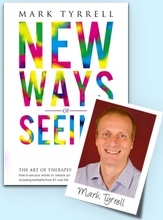
It usually takes several steps and a bit of strategy to get to the goal
Chris told me he wanted to be rid of his depression in one session.
So I told him the joke about the man who sent off for a correspondence course in muscle building. When he received the manual, he wrote back to the muscle merchants.
“Thank you, I have the manual. Now please send the muscles!”
I didn’t need to labour the point. Chris understood there was work to be done.
Prefer to watch instead?
The journey of a thousand miles… doesn’t begin with its destination
Anything worth doing, including getting over any mental health issue, needs to be done in steps.
People often run into trouble when they assume that they can do or have something – success, a wonderful relationship, a world-enhancing book – but don’t plan the steps that will lead to such accomplishments. They sort of hope that things will just fall into their laps.
They aren’t entirely to blame for this. Our media-driven age subliminally encourages the ‘wishbone where your backbone should be’ attitude to life with shows like The X Factor, America’s Got Talent, and so on promoting the idea that success is simply a matter of right time, right place.
Of course, some people do put in the necessary steps and spend twenty years becoming an ‘overnight success’ that amazes everybody. But our clients can have problems if they approach therapy in this all-or-nothing manner.
Here are 3 ways you can break down large therapy goals (such as coming out of depression) into achievable steps
1) Use the client’s metaphors to help them take the right steps
Many therapists and counsellors have asked where I get the metaphors I use. While sources like classic teaching tales are helpful, oftentimes we need only listen to and feed back the metaphors our clients themselves construct.
So if a client tells you they have ‘gone to pieces’, you might say:
Okay. Well, of course, it takes time to reassemble anything that’s fallen apart. Which pieces of your life would you like to put back together first? And how are we going to do that?
If a client tells you they feel like they’re ‘trapped in a prison’, you might ask:
Hmmm… I wonder what day release would feel like as a prelude to getting free for good? What would ten minutes or half an hour out of that prison be like? And what would you do with those moments of freedom?
I had a conversation very similar to this recently with a woman who told me that if she had just a few moments of freedom, she would “sit in my garden and just enjoy my flowers again”. I suggested it would only be for half an hour and we talked like this for a while.
The following week, she came back and told me she had enjoyed some ‘day release’ and had indeed sat enjoying her flowers and felt more at ease.
2) Keep the ball rolling – and get them rolling it
Sometimes therapy really can be quick. You might see a smoker just once or know how to treat phobias or even posttraumatic stress disorder (especially if it’s from a one-off event) in only one or two sessions.
But when someone needs help with improving their whole approach to life, they may need many more sessions. We need to keep things moving and help our clients keep from feeling bogged down by problems that seem too large to fix.
So you might ask a person who’s hoping to make more connections with more people:
What one thing can you do in the coming week to make it more likely that you’ll make contact with people?
If they can’t come up with any ideas themselves, this doesn’t mean you can’t make suggestions (such as they might email a friend they haven’t seen for ages). But the more ideas they can generate themselves, the better.
If they do just one thing each week to make things better, that, in itself, is no small thing.
3) Get them to create a ‘life manual’
It’s often said that life doesn’t come with instructions. But, actually, it does.
Our instructions come from our environment: the family and society in which we find ourselves, any books we read, movies we watch, schools we attend, and even sub-cultures we inhabit. Attitudes, ideas, norms, beliefs, and values are all, in a way, ‘instructions’.
Some people’s ‘instruction manuals’ help them. Some people’s manuals contain limiting beliefs that hinder them. But we can take the metaphor of an instruction manual and put it to good use in therapy.
The following thought experiment is a great way to get clients really thinking about constructing the steps out of their larger trouble.
Writing an instruction manual
One of the reasons why my client Chris felt depressed was because he wanted to find a partner, or in his words ‘a woman to be happy with’. I asked him how he was going to do that.
He said, “I’m just hoping and trusting it will happen one day.”
I suggested that we imagine writing an instruction manual for young men who want to meet women to be happy with. I asked him where we’d need to start.
“I guess we’d need to define ‘happy’.”
“How would you do that?”
“Well, let’s see… I think it’s a sense of feeling relaxed… feeling compatible with the other person.”
“That’s a good start,” I said. “And what sort of practical steps would we need to put in the manual to help a guy meet the kind of woman he could feel ‘compatible’ with?”
Chris looked blank for a few moments. Then: “You could meet more people if you accepted more social invitations. In fact, if you made more social invitations, you would meet more people, too. You could join a gym. Or perhaps you might change jobs, find something where you wouldn’t be working on your own all the time and there’d be plenty of people around.”
By now, he was getting quite animated. “You could work on yourself a bit, too. You could learn more social skills, how to relax more when around women. You could improve your personal grooming, that could have an effect!”
I had my notebook out and was busy writing it all down as he was speaking.
Then Chris stopped and smiled. “I’ve just written my own instruction manual, haven’t I?”
“Right!” I said. “So, where are we going to start?”
Rome wasn’t built in a day. The space race wasn’t won all at once. The journey of a thousand mastered musical pieces begins with one solitary note. And no one can order muscles through the mail.
We all need steps and mini-achievements that propel us forward into our future.










